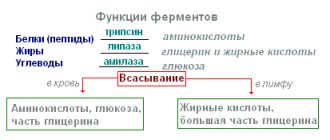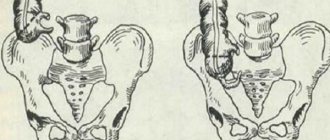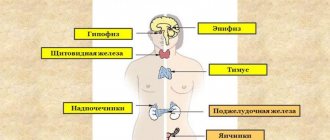Where is the human appendix located?
The appendix is part of the cecum, which is located in the right iliac fossa.
This area of the peritoneum includes:
- extreme ileum;
- cecum with vermiform appendix;
- beginning of the ascending colon.
The shape and size of the cecum with the appendix are variable due to the filling with gases and feces. In 80% of patients, the process lies in the right iliac fossa and is attached to a ligament of muscles, from which it is separated by a thin layer of fatty (retroperitoneal) tissue. In the remaining 20%, the appendix is attached directly to the tissue.
1 - high position, 2 - low position
During the autopsy, the surgeon takes into account the instability of the position of the process. Sometimes the organ is closed by the cecum or ascending colon, which provokes the development of adhesions. In this case, access to appendicitis is difficult: the appendix grows surrounded by fused muscles or grows to the posterior wall of the peritoneum.
Having seen the position of the appendix, the surgeon determines in which direction the inflammatory process has developed: towards the peritoneum or the fatty tissue of the retroperitoneal space (it is dangerous due to the development of a perirenal abscess).
To find the appendage, the doctor also takes into account the position of the bottom of the cecum, to which the appendage is attached. According to statistics, in women and men after 40, the appendix drops below the interosseous line and deepens 1–2 cm into the small pelvis.
Less common are abnormal positions of the cecal fundus:
- On the left side of the abdomen.
- In the navel area.
- In the hernial sac.
More about the anatomy of the appendix:
Anatomical features of the appendix
The appendix is a small organ, an appendage of the cecum, extending from its posterolateral wall. The cecum itself is located slightly below the place where the small intestine passes into the large intestine. The vermiform appendix is an oblong organ, on average its length varies from 7 to 10 cm, and its diameter is about 1 cm.
During the operations, the processes with the smallest and longest length were removed, their sizes being 2 cm and 25 cm, respectively. The cecum is connected to the appendix by a small hole surrounded by mucous tissue - the valve.
The usual location of the appendix is descending, that is, the appendix descends into the pelvic cavity. This arrangement of the organ was recorded in almost 45% of operated patients. With the development of acute appendicitis, the typical position of the appendix is manifested by characteristic symptoms; in women it can often resemble symptoms of inflammation of the appendages. Many people also have an atypical location of the appendix:
- An ascending position of the appendix is detected in 13% of people. This is a position in which the cecum has a process attached posteriorly, behind the peritoneum.
- The appendix can also be located medially, this is when the organ is close to the white line of the abdomen. Occurs in approximately 20% of people.
- Lateral location - the process is located near the lateral abdominal wall.
What appendicitis looks like: photo
The appendix is an organ with a complex structure and a number of features:
- Abundantly supplied with blood.
- Contains a large number of nerve endings.
- It communicates through nerve endings with other organs of the gastrointestinal tract.
The shape of the vermiform appendix is stalk-shaped. The embryonic and cone-shaped form is less common. The appendix is mobile. Atrophy of mobility indicates cured inflammation.
Photo of removed appendix
Usually the length of the vermiform appendix is 10 cm. Short, less than 1 cm, and long, more than 20 cm, appendices are observed less frequently. The average thickness is 1 cm. The dimensions depend on the age of the person. The longest appendices are observed before the age of 30. With aging, the length of the process decreases.
The importance of this part of the intestine for immunity
The beneficial functions of the appendix are an indisputable fact. The accumulation of immune tissue in the lower intestine allows lymphocytes produced in the bone marrow to accumulate inside the cells of the appendix. The body needs this to regulate vital processes in the colon.
Scientists around the world call the vermiform appendix an important organ of the immune system, because it is the place where beneficial microflora multiply. It actively produces E. coli, which is necessary for the release of the following important substances from the food coma that enters the intestines:
- fatty acids;
- carbohydrates;
- amino acids;
- nucleic acids;
- vitamin K;
- B vitamins.
The accumulation of immune tissue in the lower intestine allows lymphocytes produced in the bone marrow to accumulate inside the cells of the appendix.
This useful element is necessary for humans to regulate water-salt metabolism. During the processing of food, E. coli releases murein, a complex peptide compound that stimulates the immune system.
People need the appendix even though it is not involved in the digestion process. This “factory” continuously supplies newly formed bacteria into the intestines whenever an intestinal infection destroys them. The process of growing new colonies occurs continuously as long as a person eats properly. It is necessary to include cabbage and greens in your daily diet so that the production of lymphoid cells in the body is not suppressed. Addiction to protein foods of animal or plant origin worsens the condition of the appendix and leads to its inflammation.
With properly organized nutrition, the lymphoid cells of the appendix are most viable. They restore the body after a course of chemotherapy and constantly support protective functions during treatment of cancer. Oncologists believe that the presence of a preserved appendix in the body allows one to expect a positive reaction after radioactive radiation or radiography.
With properly organized nutrition, the lymphoid cells of the appendix are most viable. They restore the body after a course of chemotherapy.
Functions of the appendix
Functions performed by the vermiform appendix:
- Secretory. The appendage secretes a secretion that affects intestinal motility and prevents coprostasis. 3–5 ml of biologically active substance is released per day.
- Contractile. The appendix contracts periodically, regardless of the rhythm of contractions of other parts of the intestine.
- Lymphocytic. Peak function is observed in adolescence. Every minute, a huge number of lymphocytes are released from the surface of the mucous membrane, which enter the venous blood. With old age, the walls of the appendix undergo sclerosis and the lymphatic tissue is destroyed. Until a person dies, the appendix remains a reserve of the immune system in an inactive state.
- Endocrine function. Performed during intrauterine development. From the moment of birth, endocrine function is taken over by the endocrine glands of the body.
- Production of immune system antibodies. The appendix is one of the links in the production of antibodies in the body's immune response.
- Participation in digestion. The shoot is involved in the digestion of fiber and starch.
- Maintaining the microbial background in the intestines. The appendix stores a supply of microorganisms that prevent food from rotting in the intestines.
Question No. 4. What functions does the appendix perform? How does its removal affect the body?
We are sure that you have no doubt that there are some extra parts . Therefore, you have no doubt that removing the appendix without indications is a big stupidity. This makes sense only in relation to astronauts, as well as workers of some special services, in order to avoid an emergency situation when performing a task.
In humans, the appendix was until recently considered a useless organ. In the 30s of the 20th century, Germany even introduced the practice of removing it for all children. And it turned out that they did it completely in vain. Children who had their appendix removed for no reason lagged behind their peers in physical and mental development. In general, people with “accidentally” removed appendixes are more likely than others to suffer from a variety of diseases . We were unable to find out why this was happening.
So what is the appendix? Atavism, rudiment or vital organ? Why do we need an appendix and what will happen if we remove it?
Anatomy
Appendix , or vermiform appendix, is an appendage of the cecum that extends from its posterolateral wall. It is a hollow, cylinder-shaped tube approximately 8–15 cm long and about 1 cm in diameter, extending from the lower end of the cecum and closed on the other side. In other words, it is a “blind” tube that leads nowhere. The appendix can be located on the side, below, even behind the cecum, and sometimes it is adjacent to the ureter or kidney.
Study of the role of the appendix in the body
Some researchers adhere to the point of view of the American scientist David Menton, who considers the appendage to be an atavism (a relic of ancestors) or a rudiment (an underdeveloped, residual organ). Our ancestors' diet was dominated by plant foods rich in plant fibers, and the appendix was inhabited by microorganisms that took an active part in the breakdown of cellulose. After Homo sapiens moved from gathering to hunting and mastered animal husbandry, meat and dairy products , in the breakdown of which bacteria do not play a huge role, the appendix began to gradually undergo regression and noticeably decreased. In general, the conclusions of scientists of the 19th and 20th centuries were so quick and superficial that those organs for which they did not find use in the human body were declared vestigial and subject to removal.
The rudiments included many organs whose functions they could not determine: tonsils (tonsils is a misnomer from a medical point of view), thymus (thymus gland), spleen, etc. At the beginning of the 20th century, scientists counted about 180 rudimentary “useless” organs and anatomical structures in the human body. The British surgeon of the early 20th century, Baronet Sir William Arbuthnot Lane, removed the entire colon (and with it putrefactive bacteria). The surgeon performed nearly 1,000 such operations, “leaving countless victims,” the researchers wrote. And only in the 30s. In the 20th century, W. Lane’s activities began to be criticized. However, immunologists who deal with the problems of the formation and functioning of the body's defense system believe that the appendix is an accumulation of immune tissue of the intestine, into which lymphocytes that are formed in the bone marrow and mature in the thymus gland (thymus) are carried by the bloodstream.
1. serous membrane (covers the intestine from the outside) 2. muscular layer (middle layer of the intestine) 3. mucous membrane (inner layer of the intestine) 4. mesentery of the small intestine (anatomical structure in which vessels and nerves approach the intestine) 5. single lymphoid nodules 6. group lymphoid nodule (Peyer's patch) 7. circular folds of the mucous membrane.
Cross section of the appendix (histological specimen). 1. numerous depressions (crypts) in the mucous membrane of the appendix 2. lymphatic follicles (Peyer's patches); 3. interfollicular lymphoid tissue.
In the wall of the vermiform appendix there are many lymphatic vessels and lymph nodes, which ensure the destruction and neutralization of foreign substances that enter our body along with food. Cells produced by the lymphoid tissue of the appendix are involved in protective reactions against genetically foreign substances, which is especially important considering that the digestive tract is a channel through which foreign substances constantly enter. Peyer's patches (a collection of lymphoid tissue) “stand” like guards at the border.
The appendix has a very powerful lymphatic system. It has been absolutely proven that the appendix is a very important organ of the immune system. Some experts in the field of radiation medicine believe that the body's reaction to X-rays and radioactive radiation largely depends on the functioning of the appendix.
In addition, “useful” bacteria, which are in symbiosis with our body, live and are in reserve in the appendix.
Life without an appendix
In America, at the end of the last century, it was decided to carry out planned removal of the appendix for children in infancy. In children who underwent surgery, a disorder in the ability to digest mother's milk was observed; they lagged behind in mental and physical development, which was associated with impaired digestion and the development and growth dependent on it. Also, these children were more susceptible to infectious diseases, and after intestinal infections they more often developed dysbiosis. Removal of the appendix in adults can provoke the development of dysbiosis, and as a result, impaired absorption of various substances, and increase the frequency of intestinal infections.
That is, the appendix is a necessary element of our defense ; removing it unnecessarily means exposing the immune system to increased risk, and yourself to the danger of shortening your wonderful life through a misunderstanding.
How to protect yourself from appendicitis
Avoid constipation. Constipation destroys the microflora of the appendix and the entire large intestine.
It is inhabited by pathogenic microbes - provocateurs of inflammation, including appendicitis. Perform “anti-appendicitis” exercises regularly. You need to start your day with it, right after you wake up. Lie on your back, take a deep breath, then exhale and, holding your breath, draw in your stomach. As you count to five, relax your abdominal muscles. Repeat 8-10 times.
Eat more plant fiber! Fiber improves intestinal motor function and promotes the growth of beneficial bacteria that protect mucous tissues from inflammation. What products do doctors recommend first? Wholemeal bread, porridge (buckwheat, pearl barley), fruits, especially apples, plums, prunes, vegetables (carrots, beets, green onions, cabbage), seaweed.
Do not fry in the same oil twice. When you use fat left over from previous cooking for frying, putrefactive microflora develops in the cecum, which contributes to the development of colitis and appendicitis.
Do a belly massage. Lie on your back, head on a small pillow, bend your knees slightly. Place your right palm on your navel and use the pads of 2-3 fingers to perform 5-7 circular movements clockwise, gradually increasing the amplitude so that at the end the fingers touch the top of the chest and reach the pubic area from below. Repeat the stroke cycle 4-5 times. This abdominal massage is useful to do after lunch and dinner. It helps food move faster through the intestines and improves blood supply to the appendix, preventing inflammation.
Do not overuse with antibiotics. Long-term and uncontrolled use of these medications greatly affects the immune system. Antibiotics destroy the microflora - if aggressive microorganisms begin to multiply in it, inflammation cannot be avoided.
The appendix continues to be studied to this day, so it is quite possible that in the near future we will learn about its other functions. But even now we can say that there is no need to remove the appendix without a good reason. And this cause is inflammation of the appendix - acute appendicitis. In this case, it is necessary to remove the appendix, because the risk of complications and their severity are very high. Therefore, if symptoms of acute appendicitis occur, you should immediately consult a doctor!
Inflammation of the appendix
Appendicitis occurs in men and women aged 10 to 30 years. On average, this happens to 5 out of 1000 people per year.
Acute appendicitis
The causes of the disease have not yet been studied. There is an unconfirmed version that acute appendicitis is a precursor to colon and rectal cancer. This is evidenced by limited data from epidemiologists: people who did not suffer from inflammation of appendicitis were less likely to have cancer, polyps and diverticulosis of the colon.
Four main causes of inflammation:
| Cause: | Process description: |
| Mechanical | There is a blockage of the lumen between the intestine and the appendix. The following substances enter the lumen: feces, a foreign body (parasite) or a tumor. After a blockage, excess mucus accumulates in the appendix. This promotes the development of bacteria and inflammation of the mucous membrane |
| Infectious | It is believed that typhoid fever or parasitic infections can provoke inflammation of the appendix. But specific microflora for appendicitis has not yet been identified |
| Allergic | Under certain conditions, protein foods cause a delayed allergic reaction in the gastrointestinal tract. This type of reaction is characterized by a violation of the protective function of the mucous membrane of the appendix and the development of microflora, which provokes purulent inflammation |
| Angioneurotic | The muscles of the appendix spasm due to dysfunction of the neuroregulatory system, which controls the contraction of the walls of the appendix. Due to spasm, the mucous walls of the appendix swell, vascular thrombosis occurs and inflammation develops |
The period for removing inflamed appendicitis is 2 days. Prolongation of the period provokes the development of complications: diffuse peritonitis, abscess, intestinal fistula, etc.
Chronic appendicitis
A rare disease that develops after acute appendicitis. It is characterized by destructive changes in the walls of the appendix.
Patients complain of the same symptoms as with primary inflammation:
- nausea;
- weakness;
- temperature increase;
- pain and heaviness in the abdomen.
A number of authors believe that chronic appendicitis can develop without primary inflammation due to a congenital anomaly of the appendix.
The appendix and its role in the human body
A person is born with an appendix. Interestingly, already in the eleventh week of pregnancy it begins to function - however, this function is not yet related to digestion. Why a person needs an appendix will be discussed below.
How to find it
To the touch - nothing. Its dimensions are small: from 3 to 15 cm in length, and its thickness is less than a centimeter.
It is located not far from the ilium of the pelvis (this is where you can knock). On anatomical atlases, this process is depicted near the place where the small intestine passes into the large intestine. The beginning of the large intestine is a sac called the cecum, from which the appendix arises. After this, the cecum passes into the colon.
What’s interesting is that everyone took anatomy at school, but to the question “the appendix is an extension of which intestine?” few people know the correct answer.
The internal lumen of the appendix is no more than 1-2 mm. No wonder it is so prone to inflammation.
Functions of the appendix in the human body
Long-term studies show that this process is not an extra organ at all. Of course, a person lives without it, but in the conditions of civilization even those disabled people survive who in the wild would not have a chance. Society and scientific and technological progress have partly removed man from the process of natural selection.
The human appendix really does not perform a direct digestive function, as indicated by its small size. If we compare it with a horse's, which takes up a volume of 30 liters and weighs accordingly (where the horse digests cellulose), then in humans it is really a rudiment in terms of digestion. But this is far from its only function.
Research on this organ was carried out by various specialists, and it turned out that it is not at all useless. So, why does a person need an appendix:
- At the end of the first trimester of pregnancy, cells appear in the appendix that release a number of peptide hormones. Thus, at this stage of development it is a necessary organ on which the further development of the fetus depends.
- In the first years of life, the appendix works as a lymphoid organ that promotes the production of one type of leukocyte and immunoglobulin.
- The appendix is the repository of the normal microflora of the large intestine. It is no secret that humans, like other mammals, have symbiotic digestion. That is, bacteria help us digest food. Yes, they can be destroyed by antibiotics. But in people whose appendix was not removed, the microflora recovers faster after illness. This is especially important in infancy, when the body needs nutrition for rapid growth. Children whose appendix was removed at an early age are in poorer health and lag behind their peers in development.
Of course, you can wait for childhood to pass and remove it - after all, cheap lactobacterin is sold in pharmacies. But isn’t it easier not to give up what nature has given for free?
Diagnosis of appendicitis
The diagnosis of “acute appendicitis” is clinical, made by a surgeon before performing an operation to remove the appendix. The clinical picture of acute appendicitis is not always clear due to non-unique symptoms.
Palpation during the initial examination of a patient with a complaint of appendicitis
To avoid mistakes, doctors resort to laboratory and instrumental diagnostics, which include:
- General blood analysis.
- General urine analysis.
- CT scan.
- X-ray of the abdominal cavity.
- Ultrasound.
- Diagnostic laparoscopy.
Surgery is used when non-invasive methods have failed. During diagnostic laparoscopy, the surgeon determines the stage of appendicitis (catarrhal, phlegmonous, gangrenous) and, if conditions permit, proceeds to remove the inflamed appendix.
What is the appendix?
The appendix is a worm-shaped appendage that is an appendage of the cecum. The main working function of this organ is aimed at digesting plant foods. Special bacteria living in the shoot promote the absorption of cellulose by the human body.
Evolving, man gradually switched to eating other foods. Initially eating mostly plant foods, he had a large organ for processing such food.
However, having begun to consume more animal food, the appendage decreased in size. Over time, this organ transformed into a rudiment.
To a greater extent, the appendix is a kind of dust collector in the human body and thereby collects everything harmful that gets into the stomach.
A useless organ?
Until a certain time, most scientists tended to agree that this organ was completely useless.
With this opinion, doctors, not finding a proper answer to why it was still needed, removed it from patients complaining of pain in the lower right side.
However, thanks to a revolutionary breakthrough in medicine, the minds of our century have realized that people with the appendix not removed tolerate colds much easier and the food they eat is digested faster than in people with the appendix removed.
What's the point?
So what is the secret of this state of affairs? The main working effect of appendicitis is to create a barrier. Since there are bacteria in the human intestine that complicate the digestion process, there are also those that protect it from various toxins and other negative processes.
In various diseases, positive bacteria die, but those that remain in reserve quantities in the appendix begin to actively participate, multiplying and distributing useful substances with positive protective properties into the body.
People who have undergone surgery to remove appendicitis often face the problem of dysbiosis, which most often becomes the cause of intestinal infection.
Thus, this process acts as a barrier at the point of collision between normal and problem areas in the body, preventing negative microorganisms from entering the gastrointestinal tract that contribute to pathological processes and their further development.
Simply put, the appendix has the function of preventing harmful microbes from entering the intestines.
An important factor to note is that you should not underestimate the essential role of the appendix for the human body. Improper nutrition can lead to inflammation of the appendix, which threatens surgical intervention and removal, and as we have already learned and proven, this organ, although it has lost its original functions, still plays an important role in the human body. Don't ignore or underestimate him!
If you have a wide circle of acquaintances, especially close ones, you may notice that some of them have a seam about ten centimeters long on the lower right side of their stomach. You, of course, know that he appendix removed . This is the name for acute inflammation of the appendix, a vermiform appendix in one of the intestinal sections. You may even remember the picture from your ninth grade anatomy textbook where this thing was mentioned.
And since you see that a person lives and thrives without this organ, you sincerely cannot understand why this appendicitis is needed, isn’t it easier for everyone to remove it right in the maternity hospital?
How long does sick leave last after appendicitis?
A sick leave certificate is issued after surgery for 1–2 weeks. It will take so long for the body to recover. In case of complications, the sick leave is extended for the period necessary for complete recovery. After leaving the hospital, doctors recommend adhering to a gentle regimen.
Fast food banned after surgery
This applies to restrictions in:
- Food.
- Intimate life.
- Playing sports.
- Lifting weights.
- Drinking alcohol.
Lost features
In human ancestors, the appendix was a full-fledged organ that performed important functions. The purpose of the appendix was to accumulate and process cellulose obtained from tough plant foods.
In the process of evolution, man has significantly changed his eating habits and began to consume digestible food with less cellulose content. Gradually, the process of the cecum lost its function as a “storage reservoir” and is no longer vital for modern humans.
So maybe we don’t need this appendage at all? History says this is not so...
Products of evolution
If you look at the development of a human embryo, you can see that it is not quite similar to a human. This similarity is formed later, as he grows. During the development of the embryo, it forms the rudiments of the same organs that were present in distant ancestors, right down to the fish that has not yet come ashore. Sometimes you can find the following formulation: Every living creature in its ontogeny repeats its phylogeny.
Ontogenesis is the development of an individual , phylogeny is the process of development of a species from a chain of ancestors.
Now this formulation is not indisputable: in each specific organism, some characteristics disappear completely, while others develop from scratch. That is, there is a general trend, but there is no clear rule.
So, the human appendix fits into this rule.
Digestive system of vertebrates
The digestive tract was once a simple tube, and in the embryo of the first chordates it was not entirely clear where it began and where it ended (mouth and anus). Further evolution followed the path of differentiation of this system, that is, the oral cavity, esophagus, stomach and intestines appeared.
The small and large intestines finally separated in amphibians, and in amniotes (ancestors of mammals and reptiles with birds) the first cecum appeared.
It is a blind (leading to nowhere) section of the large intestine, which receives masses from the small intestine.
All mammals and birds , but the need for it is different for everyone. Therefore, in some species there are developed processes of the cecum, in others they are rudimentary, and in others they do not develop at all. Most often, the appendix (as this process is called) is developed in herbivores. It is home to colonies of bacteria that help in the symbiotic digestion of food. Carnivorous vertebrates do not have an appendix.
Excess in the human body
An organ that does not have any function in the body, but is inherited, is called a rudiment. What is considered a rudiment is a matter of debate. Ideally, this could be considered something without which one can be born, and then successfully live and reproduce. It is difficult to verify this experimentally; all that remains is statistics on those born without rudiments and with organs of this kind surgically removed. Thus, a number of anthropologists write down in rudiments:
- muscles for moving the ears;
- epicanthus;
- wisdom teeth;
- separate toes;
- separate tibia bones;
- coccygeal vertebrae;
- pyramidalis abdominis and latissimus dorsi;
- appendix;
- secondary and tertiary hair growth;
- tonsils.
Well, if everything is clear with the ear muscles, then the rest of the organs are in question. Thus, epicanthus among Asian peoples played the role of an adaptive feature in the past. A number of muscles are attached to the tailbone. Wisdom teeth are not needed by a person in a civilization, but some Australian tribes and Tasmanians, in addition to our ill-fated eights, also had nines, and with their diet these were not at all superfluous, but very necessary teeth. If you remove the latissimus dorsi muscle, then other muscles that move the arms will be overloaded, especially during power loads. In short, it's not that simple.











